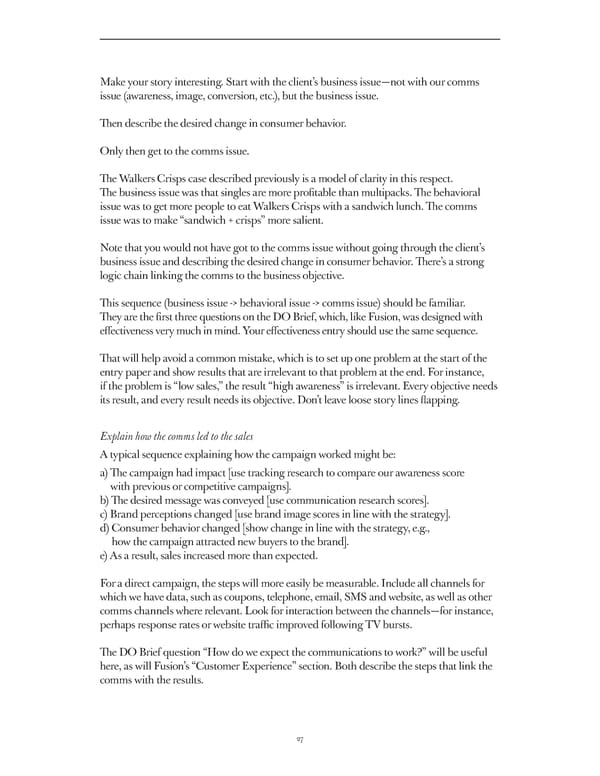Make your story interesting. Start with the client’s business issue — not with our comms issue (awareness, image, conversion, etc.), but the business issue. Then describe the desired change in consumer behavior. Only then get to the comms issue. The Walkers Crisps case described previously is a model of clarity in this respect. The business issue was that singles are more profitable than multipacks. The behavioral issue was to get more people to eat Walkers Crisps with a sandwich lunch. The comms issue was to make “sandwich + crisps” more salient. Note that you would not have got to the comms issue without going through the client’s business issue and describing the desired change in consumer behavior. There’s a strong logic chain linking the comms to the business objective. This sequence (business issue -> behavioral issue -> comms issue) should be familiar. They are the first three questions on the DO Brief, which, like Fusion, was designed with effectiveness very much in mind. Your effectiveness entry should use the same sequence. That will help avoid a common mistake, which is to set up one problem at the start of the entry paper and show results that are irrelevant to that problem at the end. For instance, if the problem is “low sales,” the result “high awareness” is irrelevant. Every objective needs its result, and every result needs its objective. Don’t leave loose story lines flapping. Explain how the comms led to the sales A typical sequence explaining how the campaign worked might be: a) The campaign had impact [use tracking research to compare our awareness score with previous or competitive campaigns]. b) Th e desired message was conveyed [use communication research scores]. c) Brand perceptions changed [use brand image scores in line with the strategy]. d) C onsumer behavior changed [show change in line with the strategy, e.g., how the campaign attracted new buyers to the brand]. e) As a result, sales increased more than expected. For a direct campaign, the steps will more easily be measurable. Include all channels for which we have data, such as coupons, telephone, email, SMS and website, as well as other comms channels where relevant. Look for interaction between the channels — for instance, perhaps response rates or website traffic improved following TV bursts. The DO Brief question “How do we expect the communications to work?” will be useful here, as will Fusion’s “Customer Experience” section. Both describe the steps that link the comms with the results. 27
 A Guide To Effectiveness Page 26 Page 28
A Guide To Effectiveness Page 26 Page 28